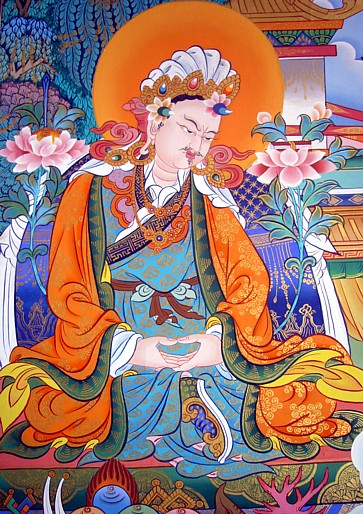King Trisong Detsen

King Tri Songdetsen (Tib. ཁྲི་སྲོང་ལྡེ་བཙན་, Wyl. khri srong lde brtsan/btsan) or Tri Songdeutsen [Déu tsen] (ཁྲི་སྲོང་ལྡེའུ་བཙན་, khri srong lde'u btsan) (742-c.800/755-797 according to the Chinese sources) – the thirty-eighth king of Tibet, son of King Me Aktsom, second of the three great religious kings and one of the main disciples of Guru Rinpoche. It was due to his efforts that the great masters Shantarakshita and Guru Padmasambhava came from India and established Buddhism firmly in Tibet.
The Wives of Tri Songdetsen
- Lhamo Tsen (ལྷ་མོ་བཙན་, lha mo btsan) from the Chim (མཆིམས, mchims) clan
- Changchub Drön (འབྱང་ཆུབ་སྒྲོན་, byang chub sgron) from the Dro (འབྲོ་, 'bro) clan
- Gyalmo Tsün (རྒྱལ་མོ་བཙུན་, rgyal mo btsun) from the Phoyong family
- Magyal Tsokarma (རྨ་རྒྱལ་མཚོ་སྐར་མ་, rma rgyal mtsho skar ma) from the Tsepong (ཚེ་སྤོང་, tshe spong) clan
- Yeshe Tsogyal from the Kharchen (མཁར་ཆེན, mkhar chen) family[1]
The Sons of Tri Songdetsen
There is some confusion in the various histories regarding the number and the names of Tri Songdetsen's sons.
According to Erik Haarh[2], he had four sons:
- Mutri Tsenpo (མུ་ཁྲི་བཙན་པོ་, mu khri btsan po),
- Mune Tsenpo (མུ་ནེ་བཙན་པོ་, mu ne btsan po),
- Muruk Tsenpo (མུ་རུག་བཙན་པོ, mu rug btsan po) and
- Mutik Tsenpo (མུ་ཏིག་བཙན་པོ, mu tig btsan po) who became known as Tridé Songtsen (ཁྲི་ལྡེ་སྲོང་བཙན་, khri lde srong btsan) or Senalek (སད་ན་ལེགས, sad na legs).
The situation is made more complex because later Tibetan sources use several of these names interchangeably. [3]
In Ancient Tibet [4], it says that there were three sons:
- Mune Tsenpo,
- Desong (ལྡེ་སྲོང་, lde srong) aka Senalek, and
- the third son, who is called both Murug and Mutik.
According to Dudjom Rinpoche's History of the Dharma (བདུད་འཇོམས་ཆོས་འཇུང་, Wyl. bdud 'joms chos 'jung), King Tri Songdetsen had three sons:
- the eldest was named Mune Tsepo,
- the middle one Murup Tsepo, and
- the youngest Mutik Tsepo, or Senalek Jingyön.
The Daughter of Tri Songdetsen
- Princess Pema Sel first died at the age of eight, but was brought back to life by Guru Rinpoche, and entrusted with the complete Khandro Nyingtik cycle by Guru Rinpoche. She was later reborn as the tertön Pema Lédrel Tsal, who revealed this terma cycle of teachings.
Notes
Further Reading
- Lewis Doney, Transforming Tibetan Kingship: The portrayal of Khri Srong lde brtsan in the early Buddhist histories (academic paper)